Replastering a pool is a common way to restore and preserve the original pool experience. There are many alternatives to plastering a pool that you should consider before plastering your pool.
Replastering your pool is a process that involves removing the old plaster and replacing it with new.
This is usually done every few years, but it is also important to do it when your pool starts to show signs of damage, such as algae, mold, or even mildew.
Pool replastering is a process that involves replacing the old plaster on the walls of a pool with a new layer.
The process is done in order to restore the appearance and feel of the pool. Several alternatives to pool replastering include fiberglass, quartz, pebble & stone, tiles, etc.
Why Should You Look for Alternatives to Plastering?
The long-term durability of plaster is questionable. The material begins to crack and tear quickly after installation. So, you’ll have to spend a great deal of money on repairs and maintenance.
Although plaster appears to be an inexpensive option, in the long run, it is more expensive. Although it is easier to install and more affordable, it only lasts seven years or so.
You may experience fading, delamination, etching, and scaling with pool plaster. Besides degrading the quality of the pool, this also ruins its appearance. Additionally, the pool is unable to handle the harsh chemicals used in cleaning.
In order to avoid paying more money later as a result of choosing a cheap option, choose alternatives that offer greater benefits and will save you money over time.
Best Alternatives To Replastering A Pool
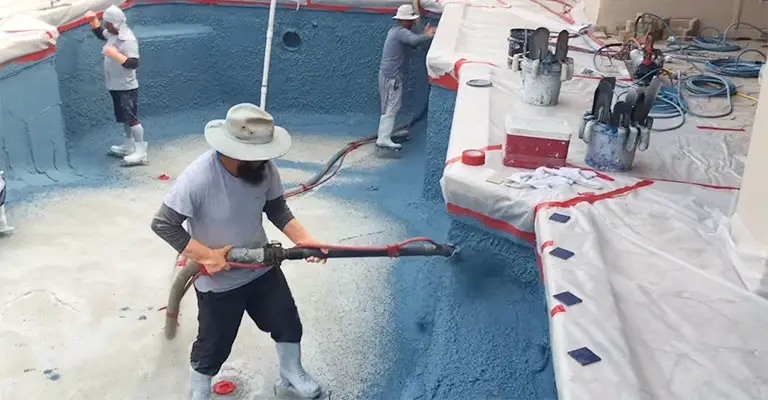
There are alternatives to white plaster that are more stain-resistant, easier to maintain, and provide longer-lasting results when replastering a swimming pool.
To choose the right alternative for your pool, you need to consider an appearance, maintenance, durability, and cost.
One of the most important factors is how well the product will maintain its color and texture for a long time without any fading or cracking.
Another factor is how well it will resist stains and algae buildup. With that in mind, here are some alternatives to replastering a pool.
Quartz
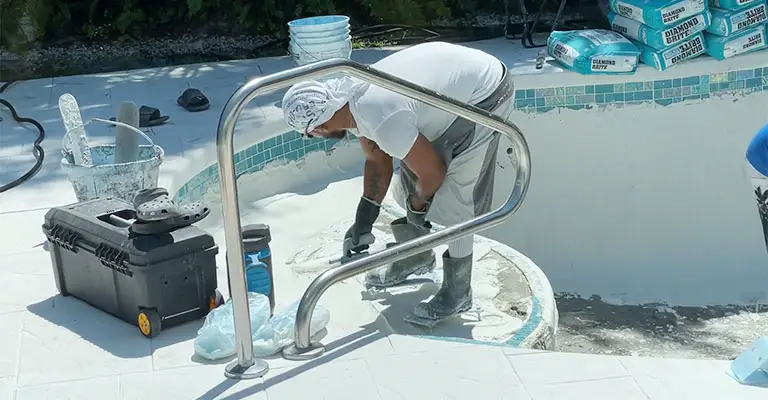
Quartz pool finishes are typically made up of a high percentage of quartz mixed with white cement. The durability and attractiveness of this finish make it a popular alternative to replastering pools.
Standard plaster typically lasts about seven years, while this type of finish usually lasts twelve to fifteen years. Quartz finishes also resist changes in chemical conditions better.
Quartz is also available in a variety of colors, from vibrant blue hues to more subtle hues like beige. In addition, swimming pools can be designed in a variety of ways using quartz.
Mineral stains and other blemishes are also better hidden in quartz finishes, giving the water a more natural appearance, like an ocean or a lagoon.
Advantages:
- The lifespan of this product is 10-15 years, which is longer than the lifetime of plaster.
- It is resistant to harsh chemicals used in swimming pools. As opposed to plaster, it also resists etching.
- The water appears more natural, like an ocean or lagoon.
- Several quartz blends are available, depending on your aesthetic preferences.
- Due to its nonporous nature, it is resistant to changing weather.
- Moreover, quartz surfaces are highly stain resistant. It is, therefore, less likely to show mineral stains.
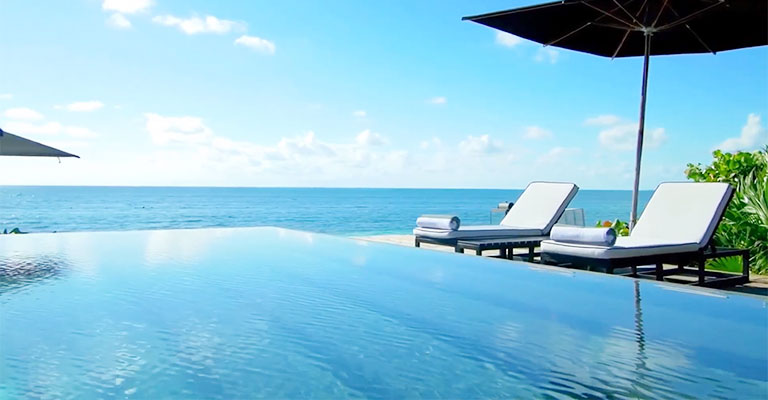
Pebble & Stone
A swimming pool with a stone or pebble finish will tend to look more natural. Stone or pebble finishes are essentially plaster mixed with different materials. These two ingredients add stain resistance and durability to the finish.
This alternative to replastering a pool is less likely to react with pool chemicals since the stone material used has no chemical properties.
They can be more expensive and rougher than standard white plaster, but they usually last for up to twenty years. Pool finishes of this type blend well with landscaped surroundings or rock scapes.
Advantages:
- The lifetime costs of this product will be lower than those of plaster.
- Pebble and stone pools do not exhibit mottling.
- The surface is slip-resistant.
- Pebble and stone finishes can be customized. You can choose from multiple designs, colors, and textures.
- Stain resistance and durability make it a very good choice.
- Compared to plaster finishes, stone and pebble finishes are more expensive, but their benefits are much better.
Fiberglass
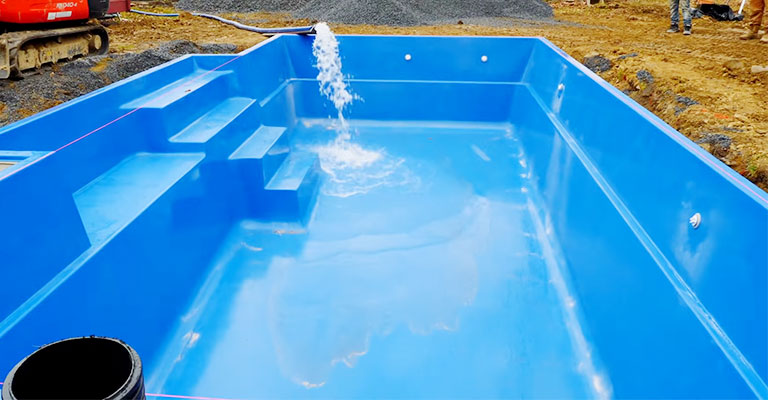
Fiberglass is the material of choice for people who are looking for less maintenance in the long run. However, fiberglass surfaces vary in durability.
That being said, they can last several decades with proper installation and maintenance. However, lower-quality fiberglass surfaces might require refinishing every four to five years.
As an alternative to replastering your pool, this type of surface is typically the least costly. In addition, fiberglass is easier to clean than plaster.
Advantages:
- You won’t have to clean it as often when you have a fiberglass pool.
- There is no need to replace the liners when using fiberglass.
- The low maintenance costs of fiberglass make it a very durable material in the long run.
- The installation of fiberglass is faster than that of other materials.
- Since the installation is not weather-dependent, it can be installed immediately after manufacture.
- The lifetime cost of fiberglass is lower.
Tiles
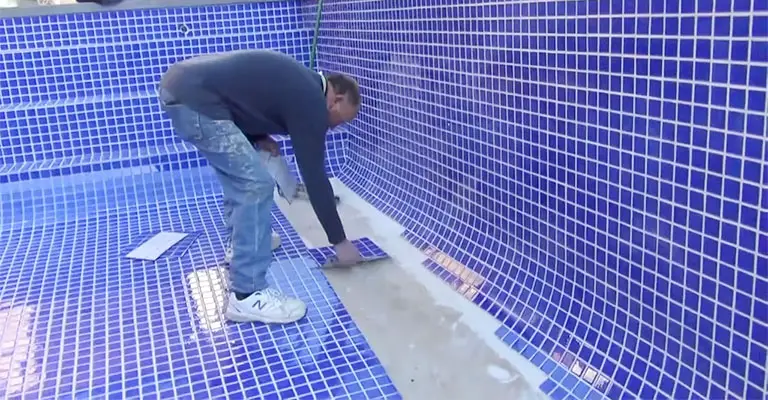
Tile is, however, a more expensive option than replastering for many people because of its high upfront cost. On the other hand, ceramic tile surfaces typically last for several decades, making them worth the investment.
Despite tile being a relatively expensive material to install in a swimming pool, many pool contractors who work on remodeling consider it to be a better alternative to regular plaster in the long run.
There is virtually no limit to the color options available with a tile pool surface. A tile pool surface is also resistant to harsh chemicals and weather conditions. To sum it up, tiles provide the pool with a premium, aesthetic appearance.
There is very little maintenance involved with either ceramic or glass tile, except for the occasional cleaning and perhaps regrouting.
Therefore, there is no need to apply acid treatments to tile, paint it, or use other invasive cleaning methods typically associated with plastered pools.
Advantages:
- There are no signs of fading or cracking on pool tiles.
- As well as being very durable, they are also very easy to maintain. Their lifespan is extremely long.
- The types of tiles you can choose from include ceramic tiles, porcelain tiles, glass tiles, etc.
- Their stain resistance is excellent. Therefore, they are easier to clean.
- The tiles of a swimming pool are made to withstand all kinds of weather and a variety of chemical treatments.
When you consider all the benefits, pool tiles are a practical choice, even if they are expensive. It’s worth considering as a replacement for replastering because it provides a premium look with practical benefits.
Frequently Asked Questions
1. How frequently should you replaster your swimming pool?
The answer to this question is more complicated than it seems. There are many factors that must be taken into account before making a decision on when to replaster a pool.
Pools can last from 5-10 years before they need replacing, but it all depends on the quality of the water being used and how often the water is changed. Also, the frequency of replastering depends on the size and the current condition of the pool.
2. Why should you replaster a swimming pool?
In order to maintain the appearance and functionality of your pool, you should replaster it every few years. You may experience aesthetic issues, as well as health-related ones if you fail to replaster your pool.
3. How can I resurface a pool at the lowest price?
Modern pool resurfacing has become more expensive, but basic white plaster is still the most affordable method. However, if you think about the long-term benefits, it is better to replaster your pool with some other materials.
Final Words
Whether you are updating or building a pool from scratch, you must select features that will give you the greatest return on investment.
For the moment, cheaper pool replaster options will satisfy your needs, but they will prove more expensive in the long run.
This article on an alternative to replastering a pool is intended to provide you with useful information. Be sure to consider all factors before making a decision. It is always good to consult a professional pool builder if needed. Choose wisely.






